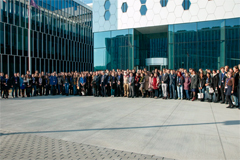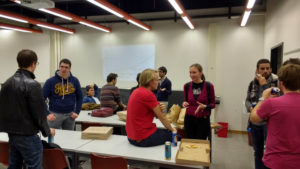 The EPFL Young Minds section expanded with success during its first full year. As planned, monthly seminars were organised under the label ‘Pizza Physics Beer’ (PPB). We noted a rise in participations from 20-30 students per seminar during the first semester, to 30-45 during the second semester. We are now 7 students fully invested in the organisation of the PPB meetings and other events.
The EPFL Young Minds section expanded with success during its first full year. As planned, monthly seminars were organised under the label ‘Pizza Physics Beer’ (PPB). We noted a rise in participations from 20-30 students per seminar during the first semester, to 30-45 during the second semester. We are now 7 students fully invested in the organisation of the PPB meetings and other events.
The subjects covered in the PPB meetings were: nuclear fusion, with a visit to the Tokamak reactor at EPFL; surface treatments to create ultra hard materials; safety measures regarding fission nuclear reactors, and the risks associated with human failure; the fabrication of anti-hydrogen at CERN; correlated dynamics in quantum systems; the use of perovskites for optoelectronic applications; the social behavior of solitons in microresonators.
This seminars were attended by PhD students from the whole EPFL Physics PhD Doctoral School (EDPY) as well as curious master students. This allowed some interaction between students, both during and after the seminar. The after-seminar gatherings lasted, in some cases, more than one hour.
Rogério Jorge, the association’s secretary, attended the leadership meeting of the EPS Young Minds associations in Naples, bringing a large number of innovative ideas to develop within the coming years, including “Physicist Speed Dating” and “Recruiting Event” activities. This first year, made possible by the EPS grants, is clearly encouraging. It reinforced us in our goal to make the EPFL physics community more interactive both within EPFL and with other members of the EPS community.
We are now focusing on the organisation of the physics day: a major event that will take place the October 16 at the Rolex Learning Center, EPFL. The four speakers of this event include the Nobel prize Stefan Hell as well as three other prominent physicists (L. O. Silva, P. Hazzi, A. Kellerer). This event will also be the occasion of a poster competition between the physics PhD students and will foster interactions among physicists of the physics doctoral school of EPFL.
School for Young Physicists
 Another school year has passed, and another SYP season has concluded as well. This year, turnout was at its highest level, with an average of 176 students taking part in each session.
Another school year has passed, and another SYP season has concluded as well. This year, turnout was at its highest level, with an average of 176 students taking part in each session.
The topics covered in the nine sessions throughout the season were:
• Deconstruction of popular urban myths with physics
• The physics of sound
• Radioelectronics
• Astronomy and cosmology
• Simple mechanisms
• Electromagnetism
• The role of numerical solutions in physics
• Geophysics
• General and special theory of relativity
Highlights of the season include (but are not limited to) using an elastic membrane to simulate the bending of spacetime, students being introduced to the numerical Euler’s method, which is never touched upon in any high-school curricula and a UL professor telling everyone the basic idea of why Earth has a magnetic field, explaining the underlying concepts of magneto-hydrodynamics.
The 2nd School Cup was awarded at the end of the season. This year, Aizkraukle Regional gymnasium’s team “Re, kā!” were the winners. They took away the main prize; second and third place winners also received prizes, as did the students that performed best throughout the season. Students thoroughly enjoyed this year, as the season closed with thunderous applause from participants.
Aside from our main sessions, we also participated in a popular nation-wide physics competition “eXperiments”, providing two out of five challenges for contestants to solve in the finals, as well as entertaining the supporters of the contestants with a small show, demonstrating a few fun experiments. The competition is running for the 22nd year, and is well known among teachers in Latvia.
Our summer season has also kicked off: as in previous years, our School for Young Physicists took part in the extreme sport festival “Playground”, once again upping our workshop in size, scope and popularity. As in previous years, staples such as the potato cannon (two, this time) and the tennis ball catapult were set up again, and popular experiments such as the hold-fire-in-your-hand and mushing around in a non-Newtonian fluid were demonstrated.
The full list of experiments and activities (in addition to those already mentioned), all free of charge, includes:
• vinegar and soda bottle rockets
• demonstrations for the gyroscopic effect with a wheel
• a self-programmed puzzle game for all ages
• a membrane for demonstrating spacetime curvature
• a large-sized wave pendulum
The last three activities were new to our workshop setup, and were very successful. In particular, the spacetime membrane with marbles on it acting as planets was popular with kids!
All in all, this year has been a success, and we will look to further improve our monthly sessions and increase the scope of our activities in the future.
Innovation and entrepreneurship lunches
 During Wednesday’s lunchtime on April 26, the Line of Light auditorium was crowded with 80 bachelor, master and PhD students interested to hear about optics and photonics technologies in the “Lunch with Industry” event. After grabbing a sandwich with soda, they focused their attention firstly to Peter Skovgaard, CEO and Co-founder from Norlase, and later to Sidsel Petersen, representing NKT Photonics company. Peter made a short overview of how their novel high-power visible laser technology allowed them to become a promising start-up company with a vision to outperform currently leading solutions available on the market. Sidsel, on the other hand, shared the vision and perspective of NKT Photonics – one of the leaders in the market of high performance fiber and laser technologies. She was generous enough to bring some of the examples of industrial photonic crystal fiber products, components, and materials used in fabrication.
During Wednesday’s lunchtime on April 26, the Line of Light auditorium was crowded with 80 bachelor, master and PhD students interested to hear about optics and photonics technologies in the “Lunch with Industry” event. After grabbing a sandwich with soda, they focused their attention firstly to Peter Skovgaard, CEO and Co-founder from Norlase, and later to Sidsel Petersen, representing NKT Photonics company. Peter made a short overview of how their novel high-power visible laser technology allowed them to become a promising start-up company with a vision to outperform currently leading solutions available on the market. Sidsel, on the other hand, shared the vision and perspective of NKT Photonics – one of the leaders in the market of high performance fiber and laser technologies. She was generous enough to bring some of the examples of industrial photonic crystal fiber products, components, and materials used in fabrication.
…Thanks to Norlase and NKT Photonics for shedding some light on current status of the laser industry!
A week later, on Friday 5, serial entrepreneur David Hardwick gave the talk “Science for profit and fun in the laser industry” accompanied by Prof. Jes Broeng. The duo addressed entrepreneurship, and shed light on some of the best ways to start a business in an effort to inspire students with innovation dreams.
David Hardwick is co-founder and Chairman of Norlase and Fauna Photonics in Denmark and an investor and advisor at BiFrost Communications. David is a past member of the Optical Society of America (OSA) Board and the OSA Foundation. He is a consultant to IMRA America and other companies in the industry.
During this event, everybody got a chance to pick the two entrepreneurs’ brains at the following discussion and plenty of opportunity to mingle. What a great afternoon!
Outreach towards secondary and primary schools
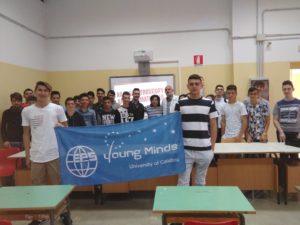 We have introduced phenomena, concepts and materials in the fields of optics and materials science to students of secondary and primary schools.
We have introduced phenomena, concepts and materials in the fields of optics and materials science to students of secondary and primary schools.
Activities have been carried out both at schools and at University of Calabria and in both cases they have been divided into (i) simple experiments and demos and (ii) simple lessons.
Some lessons have been necessary in order to give them the minimal background in order to understand the simple experiments. However, we have started with experiments since we have noticed that in this way the lessons are found more interesting and funny by the students. In other words, the students are more interested in understanding what they have just seen that the reverse. In any case, the lessons to explain the concepts behind physical phenomena have been organized with in mind the requirement to be interactive and funny.
The first experiments organized directly at schools were focused on light (light-emitting devices and light propagation). In the last meetings, we have even introduced the nanoworld with simple demos.
Some new experimental apparatuses for outreach have been shown at students and successively described in most basic details, with a particular emphasis for the potential application fields of the topic. We have used also some videos in order to stimulate the visual memory of the students.
For the case of primary schools, we have shown how colors are formed with very simple considerations to support the experiment.
A discussion with students of secondary schools about the prospect of nanotechnology and nanoscience has been also organized. During the visit at University of Calabria, we have presented with simple words the new facilities on nanospectroscopy and nanomaterials recently installed at our University and their possible connection to the technological applications. In this case, we have formulated in a much simpler way (for secondary schools) the most intriguing concepts that have been discussed in the Seminar Activity of our EPS-YM section, instead oriented toward undergraduate and PhD students.
During the visit to the University, the students have been invited to participate actively to a low-energy electron diffraction experiment unveiling the position of atoms at surfaces of topological materials. Subsequently, a short and simple discussion to understand why the last Nobel prize for Physics has been awarded to studies on topological materials.
Refreshments with some beverages and snacks have been offered after each meeting to the students and to teachers. We acknowledge both teachers and local administrations who have nicely supported us in all the phases of the project.
Physics for everyone LIVE
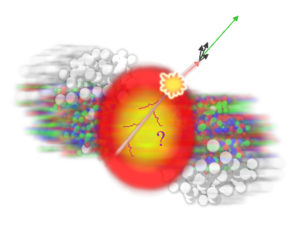 Primarily we designed this program for primary and secondary school pupils. During the day the kids could choose several type of activities. We cooperated with some academic teachers from Eötvös Loránd University and Budapest University of Technology and Economics, that gave some lectures about Cosmology, Big Bang Theory and etc. Besides these lectures we wanted to show some interesting physics experiments from the everyday physics and modern physics, like how to use apps for measuring the sound intensity, and how to make ice cream with liquid nitrogen, and we had a self-made cloud chamber. During this time some of our people made some spectacular explosions in the yard. We considered it is important to speak about the new energy resources, so we made a special corner for the fusion power, with the help of the guys from the Wigner Research Center. During these activities the Wigner Research Center made available for us their moving experimental station (the all-colour of Physics bus). This is an interactive exhibition about the wide range of physics of nanostructures. We had more than one thousand visitors just in the University, it is twice as much as last year, and we have more than ten thousand visitors across country because many school joined to our program . After the event we asked the visitors what they thought about the activities. We got many positive responses, and i think in this event we learned a lot about the technics of of presentation and any other skill so we can do this better next year.
Primarily we designed this program for primary and secondary school pupils. During the day the kids could choose several type of activities. We cooperated with some academic teachers from Eötvös Loránd University and Budapest University of Technology and Economics, that gave some lectures about Cosmology, Big Bang Theory and etc. Besides these lectures we wanted to show some interesting physics experiments from the everyday physics and modern physics, like how to use apps for measuring the sound intensity, and how to make ice cream with liquid nitrogen, and we had a self-made cloud chamber. During this time some of our people made some spectacular explosions in the yard. We considered it is important to speak about the new energy resources, so we made a special corner for the fusion power, with the help of the guys from the Wigner Research Center. During these activities the Wigner Research Center made available for us their moving experimental station (the all-colour of Physics bus). This is an interactive exhibition about the wide range of physics of nanostructures. We had more than one thousand visitors just in the University, it is twice as much as last year, and we have more than ten thousand visitors across country because many school joined to our program . After the event we asked the visitors what they thought about the activities. We got many positive responses, and i think in this event we learned a lot about the technics of of presentation and any other skill so we can do this better next year.
We have some pictures in here : https://drive.google.com/open?id=0B4R1tDrTxGkWQWJKc0gwbHFOM2c
Fun with physics – demonstrations in kindergarten
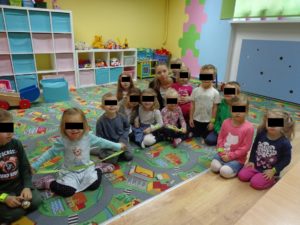 Within our formed WrUT EPS Young Minds section all of our members have the experience in the outreach field. We have been very successful in that area in the OSA & SPIE student chapters, that is why we wanted to introduce these kind of activity in the newly form section.
Within our formed WrUT EPS Young Minds section all of our members have the experience in the outreach field. We have been very successful in that area in the OSA & SPIE student chapters, that is why we wanted to introduce these kind of activity in the newly form section.
This project was a big success. There wasn’t any problem in changing the scope of our lectures from optics to basic physics. For children in primary school and especially in preschool every scientific presentation is a lot of fun. It also brings to them an inspiration to thinking about the experiment, its result and asking question. As from our observation these children who cannot ask any question react in a special way, on their face you can see at the beginning surprise with disbelief, after that they want to repeat the experiment by their own. When they finally convince their self that experiment show true result they have more curiosity to see and experience another demonstration, which is one of our goal to increase the interest of our physical world.
We carried out demonstrations in one of the biggest kindergarten connected with the primary school in Wroclaw, Poland. The number of attendees where around 80 children (4 groups with around 20 children in each). Our presentation was divided for parts related with air, water, light and balance. At the end some of the children wanted to bring few experiments back again to demonstration, because of their high attraction, so we combined the topics.
In our opinion this project was a success. We increased the children’s curiosity of the physical world, their also trained the ability to perform some of the experiments by their own. The challenge of searching discussed phenomena in their surrounding world went also well. We had a bit of problems with the team work, because all the kids wanted to do the experiment at one time, but for us it was an opportunity to gain some teaching experience. We don’t see any problem to repeat such project in the future if our members will bring the will to do so.
Open Readings – YM BAA 2017
- Prof. Ben Feringa (Netherlands) – 2016 Nobel Prize laureate in Chemistry, h-index: 103;
- Prof. John Ellis (UK) – one of the most known theoretical physicist working at CERN, h-index: 150;
- Prof. Philip Russell (Germany) – former president of OSA and leader in the field of photonic crystal fibers, h-index: 86;
- Prof. Michael Graetzel (Switzerland) – Millennium Technology Prize laureate, 3rd most cited chemist in the world, h-index: 207;
- Prof. Xi-Cheng Zhang (USA) – one of the best known researchers of THz technologies, h-index: 70;
- Prof. Eugenio Coccia (Italy) – co-author of the gravitational waves discovery, h-index: 43;
- Prof. Naomi Halas (USA) – one of the leaders in the field of plasmonics and the use of nanoparticles in cancer treatment, h-index: 106.
- Prof. Robin Lovell-Badge (UK) – active scientist and policy maker in the field of genetics, h-index: 66;
- Prof. Frederik Clayessens (UK) – novel material creator by using various light sources, h-index: 23;
Science fairs & Interactive lectures
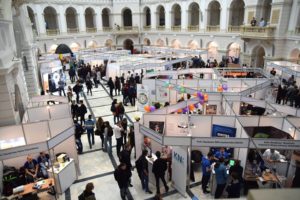 Warsaw University of Technology EPS Young Minds Section organised and participated in several events aiming to promote physics and science among children and local community. Physics can be fun and very attractive for young kids. Thanks to a grant from EPS, WUT section was able to demonstrate great new experiments adjusted to the age of participant. WUT EPS organised a visit to the local kindergarten with a fairytale full of optical phenomena. Kids were learning, while having a good time.
Warsaw University of Technology EPS Young Minds Section organised and participated in several events aiming to promote physics and science among children and local community. Physics can be fun and very attractive for young kids. Thanks to a grant from EPS, WUT section was able to demonstrate great new experiments adjusted to the age of participant. WUT EPS organised a visit to the local kindergarten with a fairytale full of optical phenomena. Kids were learning, while having a good time.
The section attended also the biggest outdoor science fair in Europe: “Science Picnic of Polish Radio and The Copernicus Science Centre” at the National Stadium in Warsaw.
It is Europe’s largest outdoor event aimed to promote science. Every year, it attracts crowds (over 100 thousand) of visitors to Warszawa. Scientific institutions, universities, research institutes, museums, cultural institutions, and foundations related to science and science clubs present their achievements and reveal the behind-the-scenes aspects of their everyday work. This year’s theme was: “Health and inventions”, so we tried to show how light-based technologies are used in medicine.
Next event the Warsaw section attended was organised by Warsaw University of Technology. It was an educational picnic “From micro to macro” for kids mainly from primary schools.
In september section organised a game: “Rycerze koherencji: W poszukiwaniu gargulca” and a lecture on holography, as a part of Warsaw Festival of Science.
The target of this event was students from primary and secondary school. A game in which the participants under the pretext of searching Gargoyle learn about the phenomenon, and devices used in optical measuring, among others, interferometry, thermal imaging, 3D scanning and luminescence. The lecture was prepared for older audience, so everyone could find something for themselves.
Sounds right? Sounds good!
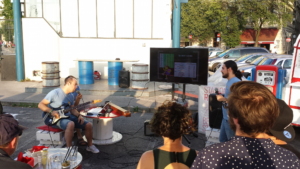 Besides the various big science events that take place in Trieste, we believe it is important to bring
Besides the various big science events that take place in Trieste, we believe it is important to bring
scientific dissemination to the general public also in its every day life. For this reason, we like to
organize events in pubs, to talk about science in a relaxed setting. Last summer, we had a talk
entitled “Sounds right? Sounds good!” about the physics of music at a pub, just before a local band
played some good music. With the help of a guitar and a string, we talked about how music is
described by waves, what spectral range we humans are able to hear and what the role of
harmonics is in the characteristics of the various music instruments.
Mini Maker Faire – Science Picnic
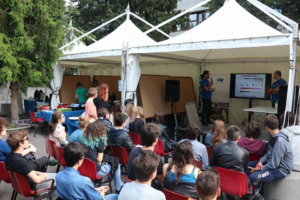 Trieste has a very high concentration of research centres. This results in various big scientific events,
Trieste has a very high concentration of research centres. This results in various big scientific events,
which gather people from the institutes and university to present their activity to the general
public. Among these events there are the Mini Maker Faire and the Science Picnic, which in 2016
took place consecutively at the International Centre for Theoretical Physics, in which we took part
with our own stand. There, we presented to the public facts about space science and the Solar
System. We had 3D-printed models of comet 67P/Churyumov-Gerasimenko and of the ESA Rosetta
probe, paper models of the Rosetta probe to give out to kids, posters on the Solar System and a
binocular, which projected on a cardboard the Sun and a solar spot.
Besides our stand, we had many time-slots to present our talks on the physics of music (“Sounds
right? Sounds good!”), the ESA Rosetta mission, the measurement of the cosmic microwave
background, and the observation of the sky in the infrared spectral range from the Antartic and
from space. In more detail, the measurement of the CMB was discussed with the aid of guitar, to
present it in analogy to the description of waves on a string. The talk on the observation of the
infrared sky was, instead, in the form of a double talk with two speakers, each arguing in favour of
his preferred kind of location.
The number of people reached in these events is large, since these attract people both from the city
and from the whole Friuli-Venezia Giulia region. The total number of visitors to the Mini Maker Faire
has been estimated by the organizers to be 18000. Given its success, we will participate also in the
2017 edition.

